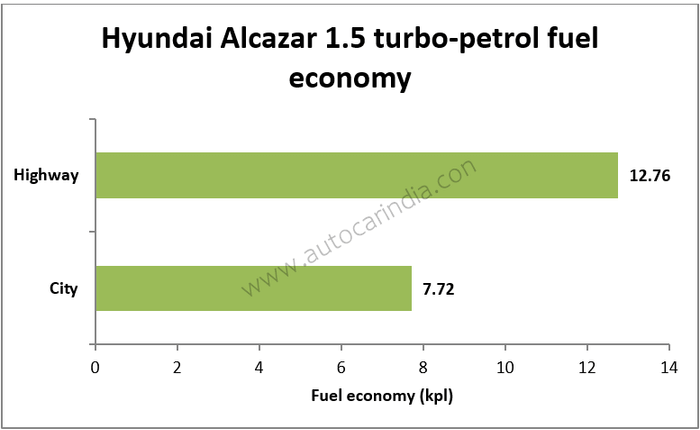Hyundai Alcazar 1.5 turbo-petrol real world fuel economy tested, explained
The Alcazar 1.5 turbo-petrol features fuel-saving auto start/stop tech.
Published On Jun 17, 2023 08:00:00 AM
42,670 Views
Follow us onHyundai recently launched the updated Alcazar with refreshed looks and a new 1.5-litre turbo-petrol engine replacing the 2.0 MPi. We’ve now had a chance to put it through our instrumented fuel efficiency tests to find out how it performs in the real world.
- New 160hp turbo-petrol engine replaces older 2.0 MPI engine
- Fuel efficiency test was conducted in Eco mode
- Test was conducted in peak summer with high ambient temperatures
Hyundai Alcazar turbo petrol fuel economy
The Hyundai Alcazar we tested was powered by a 160hp, 1.5-litre turbo-petrol engine that was mated to a 7-speed dual-clutch automatic gearbox. In our fuel efficiency tests, the Verna Turbo, which uses the same powertrain, managed 10.76kpl in the city and 16.05kpl out on the highway.
Given that the Alcazar is a larger car and the fact that it weighs 185kg more than the Verna Turbo, fuel efficiency, as expected, is lower. While Hyundai claims the Alcazar turbo-petrol will do 18kpl, we only managed to get 7.72kpl in the city and 12.76kpl on the highway in Eco mode, which, despite Hyundai introducing fuel-saving auto start/stop tech, isn’t great.
However, it’s worth noting that our tests were carried out in peak summer with ambient temperatures hovering around 40-deg Celsius. This, in turn, meant that the AC compressor was on for the entirety of our run, preventing the Alcazar's engine from turning off even at traffic signals, thereby impacting fuel efficiency.

Autocar India’s fuel efficiency testing
Before our real-world fuel efficiency test, we fill the tanks of our test cars to the brim and maintain tyre pressures based on the manufacturer’s recommendation. These cars are driven in fixed city and highway loops, and we maintain certain average speeds. Throughout our test, we ran the air-con, ventilated seats and other electricals like the audio system, indicators and wipers when required, just like how a regular user would. Periodic driver swaps further neutralise variations in driver patterns. At the end of each cycle, we calculate efficiency by filling them up to the brim again.
Also read:
Hyundai Alcazar 1.5 turbo-petrol review: Change of heart
Copyright (c) Autocar India. All rights reserved.





Comments
Member Login
Personal Details
No comments yet. Be the first to comment.